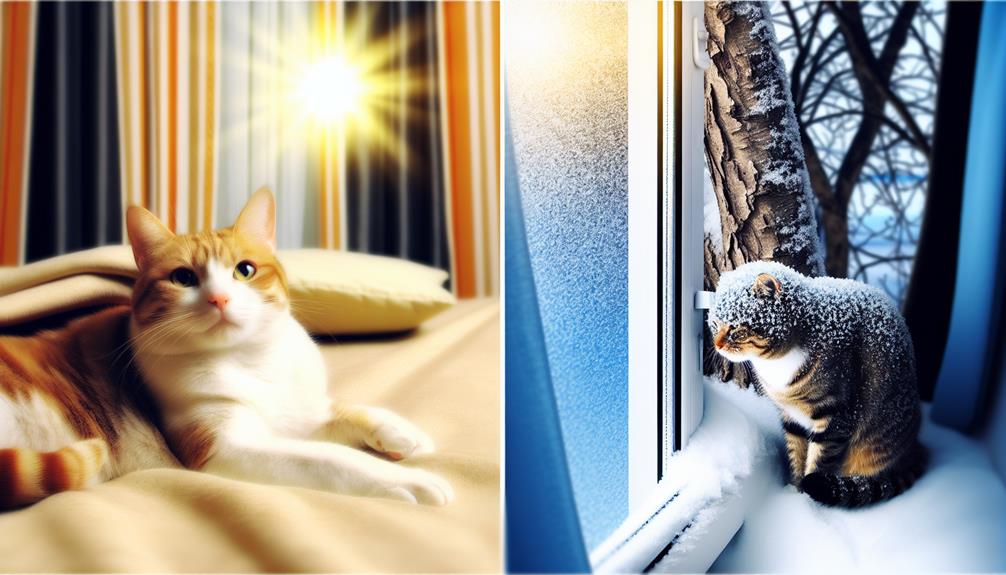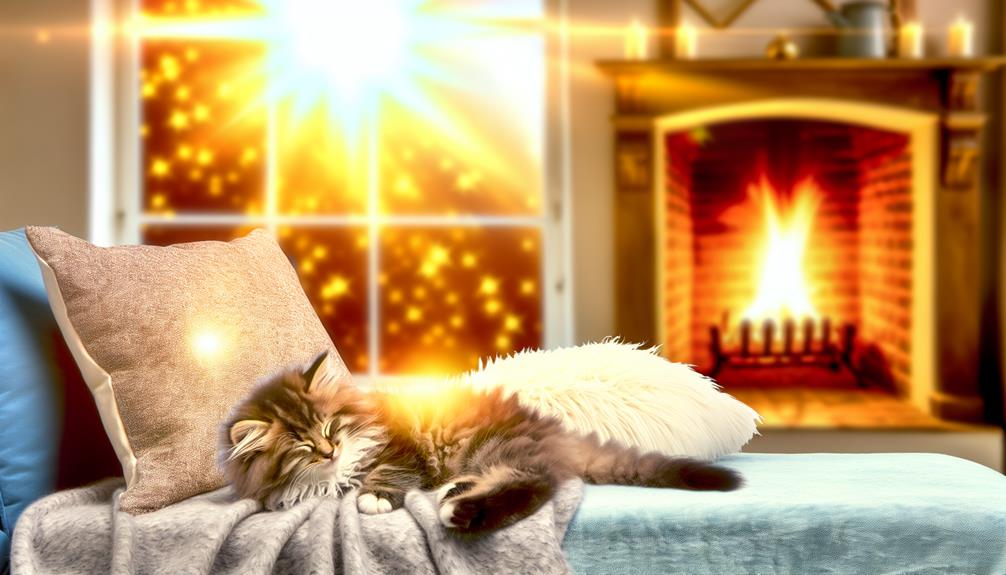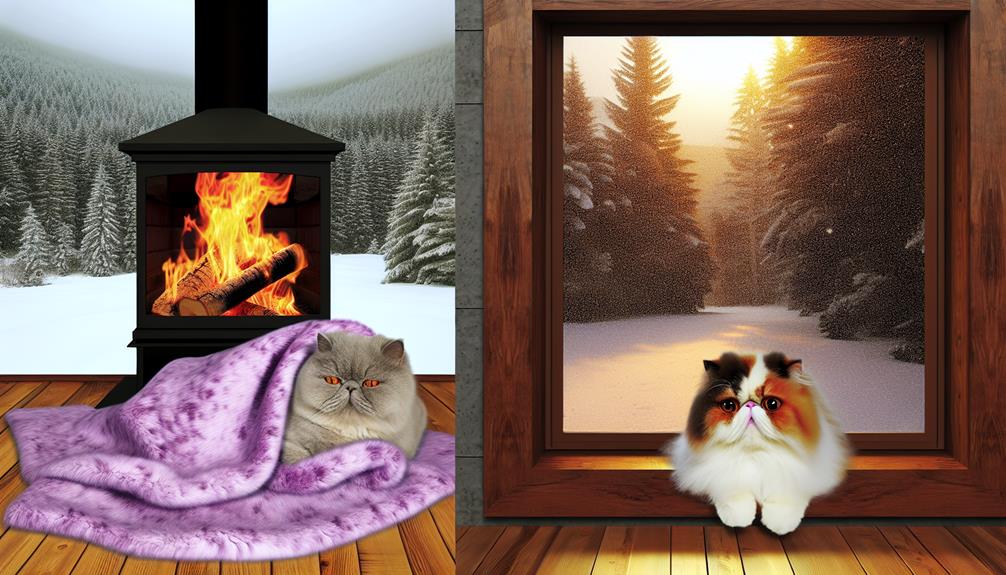You might think that with their fur coats, cats wouldn't get cold, but they certainly can, especially when temperatures drop. Their core body temperature is similar to ours, ranging from 100.5°F to 102.5°F, so they feel the chill more than you might realize. If you've ever noticed your feline friend seeking out warm spots or shivering, these are clear signs they're uncomfortable. Indoor and outdoor cats face different challenges, and while your indoor cat benefits from a stable climate, outdoor cats need extra care. Ever wondered what you can do to keep your cat warm and comfortable?
Feline Thermoregulation
Feline thermoregulation is a sophisticated physiological process that enables cats to maintain their core body temperature within a narrow, ideal range. It is important to understand that a cat's body temperature is typically between 100.5°F and 102.5°F. This precise regulation is essential for their metabolic functions and overall health.
Cats possess an intricate system of thermoreceptors that detect changes in environmental temperatures. These receptors are highly sensitive and help the cat's body respond effectively to temperature variations. For instance, when exposed to cold, thermoreceptors stimulate processes that generate and conserve heat. This temperature sensitivity is enhanced by the feline fur, which plays a significant role in insulation. A cat's fur traps a layer of air close to the skin, acting as a thermal barrier against cold environments.
Additionally, the hypothalamus, a part of the brain, acts as the central thermostat in cats. It processes information from thermoreceptors and initiates appropriate physiological responses. These responses include shivering, which generates heat through muscle activity, and peripheral vasoconstriction, which reduces blood flow to the skin to minimize heat loss.
Moreover, behavioral adaptations complement these physiological mechanisms. Cats might seek warm places or adopt compact postures to reduce exposed surface area, thereby conserving heat. The efficacy of these thermoregulatory strategies can be influenced by factors such as age, health status, and breed-specific characteristics of feline fur.
Understanding feline thermoregulation allows you to appreciate how adeptly cats manage their body temperature. However, it is important to be mindful of environmental conditions, as extreme temperatures can challenge their regulatory systems. Ensuring a suitable environment helps maintain their comfort and well-being.
Signs Your Cat Is Cold
One can often recognize the signs that a cat is cold by observing specific behavioral and physiological indicators. Cats, like humans, exhibit various responses to cold environments due to their cold sensitivity. You might notice your cat seeking warmer areas, such as snuggling close to heating vents or burrowing under blankets. These behaviors are instinctual, driven by the need to maintain ideal body temperature.
Additionally, cats may exhibit a hunching posture, tucking their paws and tail close to their body to reduce heat loss. Shivering is another clear sign; it's an involuntary response aimed at generating warmth through muscle activity. Pay close attention to their ears and paws, which are more susceptible to cold. Cold extremities can indicate that your cat's overall body temperature is dropping.
Here's a quick reference table for the signs your cat may be cold:
| Behavioral Signs | Physiological Signs |
|---|---|
| Seeking warm spots | Cold ears and paws |
| Hunching posture | Shivering |
| Reduced activity | Lethargy |
Reduced activity levels can also imply discomfort due to cold. Cats are less likely to engage in playful behavior when they're trying to conserve energy for warmth. Lethargy can be particularly concerning, as it signifies a more severe response to cold exposure.
Understanding these signs allows you to take proactive measures in ensuring your feline companion remains comfortable and healthy. By recognizing these cat behaviors, you can mitigate cold sensitivity issues and provide a warm, safe environment. Evidence-based strategies include providing heated beds and maintaining a consistent indoor temperature. These interventions can greatly improve your cat's well-being during colder months.
Indoor Vs. Outdoor Cats

Recognizing the signs that your cat is cold is essential to guaranteeing their comfort, whether they're indoor or outdoor cats. Indoor cats generally benefit from a stable indoor climate, which minimizes their risk of exposure to cold temperatures. However, this doesn't mean they're entirely immune to feeling cold. Factors such as poor insulation, drafts, and individual health conditions can contribute to an indoor cat's discomfort. You should monitor for signs such as shivering, seeking warmth, and lethargy, which indicate that your cat might be cold.
Outdoor cats face a higher risk of cold exposure, as they are subject to varying weather conditions. Providing adequate outdoor shelter is critical. An ideal outdoor shelter is insulated, elevated off the ground, and equipped with a door that minimizes drafts. Straw bedding is preferred over blankets, as it retains heat better and stays dry. Regularly check the shelter to guarantee it remains dry and free of debris.
The metabolic rate of outdoor cats increases during colder months to maintain body temperature, necessitating an increased caloric intake. Guarantee they have access to high-quality food and unfrozen water to support their energy needs and overall health.
Comparatively, indoor cats might require less caloric adjustment but still need a warm environment. Utilizing heated cat beds or blankets can provide additional comfort. Both indoor and outdoor cats benefit from regular veterinary check-ups to monitor for cold-related health issues, such as hypothermia and frostbite.
Winter Safety Tips
Guaranteeing your cat's safety during winter involves implementing several evidence-based strategies to protect them from cold-related health risks. By adopting a meticulous approach, you can minimize the potential for hypothermia, frostbite, and other cold-induced conditions. Let's explore some key winter safety tips.
- Heating Options: Evaluate the indoor heating options available for your cat. Make sure you maintain a consistent indoor temperature, ideally between 65-75°F (18-24°C). Consider using heated cat beds or pads, which provide localized warmth and can be particularly beneficial for older cats or those with arthritis.
- Outdoor Shelters: If your cat spends time outdoors, providing a well-insulated outdoor shelter is essential. The shelter should be elevated off the ground to prevent moisture accumulation and have a small entrance to retain heat. Line it with straw rather than blankets, as straw repels moisture and offers better insulation.
- Nutritional Adjustments: Cats require more calories during cold weather to maintain their body heat. Make sure you provide a high-protein, high-fat diet to meet these increased energy demands. Additionally, ensure their water supply doesn't freeze, as hydration is vital for thermoregulation.
- Regular Health Checks: Regular veterinary check-ups are imperative during winter. Cold weather can exacerbate underlying health conditions, such as arthritis and respiratory issues. A thorough examination can help identify any early signs of weather-related health problems, enabling prompt intervention.
Implementing these winter safety tips will greatly enhance your cat's well-being during colder months. By focusing on heating options, outdoor shelters, nutritional adjustments, and regular health checks, you can provide a safe, warm, and comfortable environment for your feline companion.
Ideal Sleeping Spots

When considering where your cat should sleep during colder months, it's crucial to understand their preference for warm, secure environments. Cats naturally seek out preferred locations that provide both warmth and a sense of security. Understanding these preferences can help you create the ideal sleeping spots for your feline friend.
Evidence suggests that cats are instinctively drawn to cozy hiding spots. These areas mimic the enclosed spaces they would seek in the wild to stay safe and warm. Typical preferred locations include areas elevated from the ground, which not only provide warmth but also offer a vantage point to monitor their surroundings.
| Preferred Location | Characteristics |
|---|---|
| Radiator Shelves | Elevated, warm, and secure |
| Enclosed Cat Beds | Insulated, soft, and enclosed |
| Blanketed Window Seats | Elevated with sunlight access |
| Under Furniture | Low light, enclosed, and warm |
Radiator shelves are an excellent option, as they leverage the heat from your home's heating system. Enclosed cat beds with insulated walls offer a controlled micro-environment where your cat can retain body heat effectively. Blanketed window seats provide the dual benefit of elevation and natural sunlight, which can greatly warm up the spot during daytime. Finally, spaces under furniture are often cozy hiding spots due to their enclosed nature and proximity to floor heating.
Incorporating these preferred locations into your home guarantees that your cat has multiple options to choose from, depending on their immediate need for warmth and security. By understanding these preferences, you're better equipped to provide a comfortable and warm environment for your cat during the colder months.
Choosing Cat-Friendly Fabrics
Selecting the right fabrics for your cat's bedding and lounging areas can greatly impact their comfort and well-being. Different fabric types offer various benefits and drawbacks, and understanding these can help guarantee your cat stays warm and cozy, especially during colder months.
- Fleece: Known for its excellent insulation properties, fleece is a popular choice for cat beddings. This synthetic fabric traps heat effectively, keeping your feline friend warm. Additionally, it's soft and comfortable, making it an inviting material for cats to snuggle into.
- Cotton: Cotton is a breathable, natural fabric that is hypoallergenic and gentle on your cat's skin. While it doesn't insulate as well as fleece, it's perfect for layering. You can add cotton layers underneath other, warmer fabrics to create a versatile bedding setup that adapts to varying temperatures.
- Wool: Wool provides exceptional warmth and has natural moisture-wicking properties. This makes it an ideal fabric type for beddings, especially in colder climates. However, wool can sometimes be a bit scratchy, so consider a wool blend or a wool layer beneath a softer fabric to guarantee maximum comfort.
- Microfiber: Microfiber is another synthetic fabric that offers both warmth and durability. It's resistant to stains and easy to clean, making it a practical option for cat beddings. Its soft texture is also appealing to cats, making it a cozy choice for their lounging areas.
Conclusion
In summary, guaranteeing your cat's comfort in colder conditions is paramount. By recognizing the signs of cold stress, offering warm, cozy spots, and selecting appropriate fabrics, you're safeguarding their well-being. Outdoor cats, akin to soldiers braving the elements, require extra care and energy to stay warm. By following these evidence-based guidelines, you'll guarantee your feline friend remains healthy and snug, regardless of the weather. Remember, a warm cat is a happy cat.
